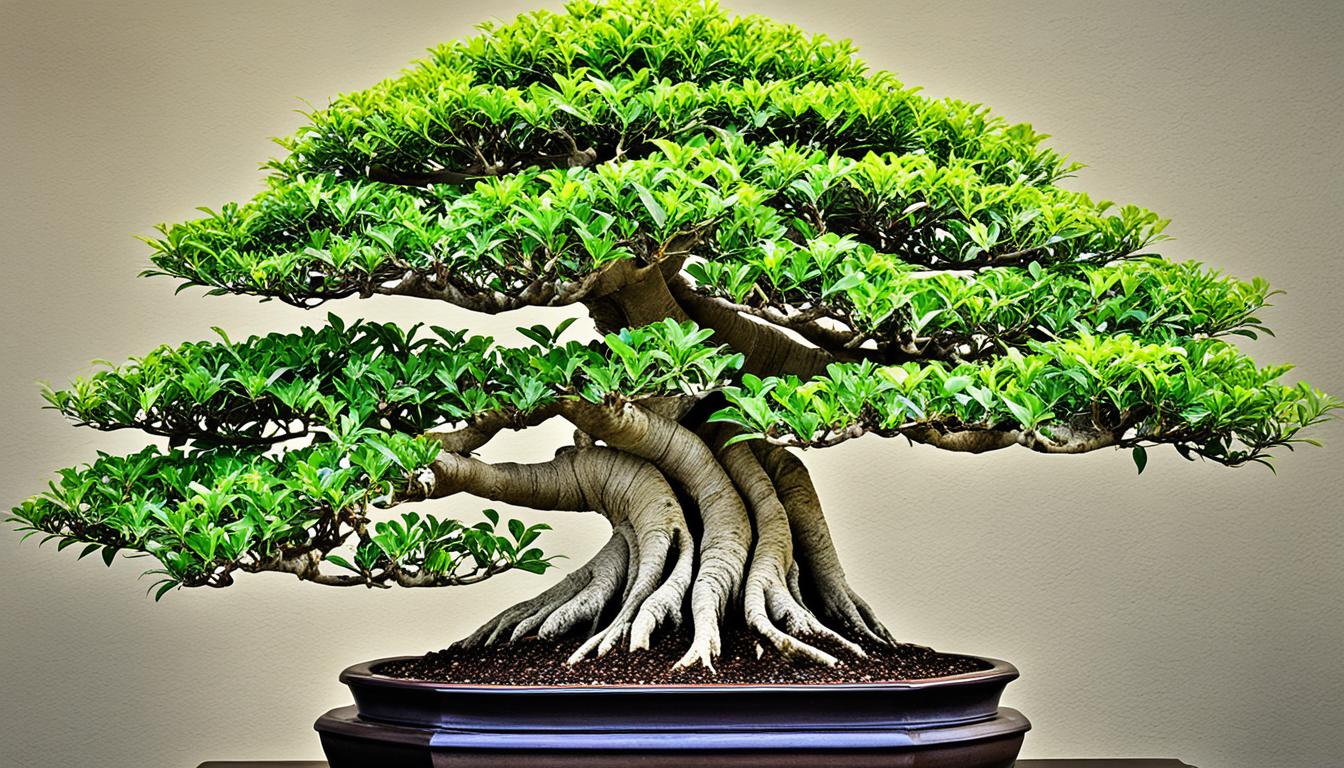Did you know Bonsai Ficus trees have been around for thousands of years? These tiny trees make your indoor space look great. They also need careful attention to do well. In this guide, I’ll show you how to grow and care for Bonsai Ficus trees at home. You’ll learn how to make a lovely and healthy indoor garden.
Key Takeaways:
- Bonsai Ficus trees have a long history of cultivation.
- Proper care and maintenance are essential for the health and beauty of Bonsai Ficus trees.
- Growing Bonsai Ficus trees in apartments requires understanding their unique needs.
- From pot selection to pest control, every aspect of Bonsai Ficus care will be covered in this guide.
- By following the tips and techniques shared, you can successfully grow and enjoy your own Bonsai Ficus tree.
Why Do We Love the Bonsai Ficus For Apartments?
The Bonsai Ficus is a top pick for people living in apartments. It’s charming and brings many benefits to any home. We’ll look at why this plant is great for apartment life.
Is the Bonsai Ficus Air-Purifying?
The Bonsai Ficus is more than just pretty. It cleans the air in your home. It takes in bad stuff like formaldehyde and makes the air healthier. So, you and your family breathe cleaner air.
Is the Bonsai Ficus Pet Friendly?
If you have pets, you’ll want safe plants around. Luckily, the Bonsai Ficus is safe for pets. But watch out, some pets might get a bit sick from it. If your pet acts weird, talk to a vet.
How Big Does the Bonsai Ficus Get?
The Bonsai Ficus stays small and that’s great news. It looks like a big tree but is kept tiny on purpose. It fits perfectly in small spaces in your apartment.
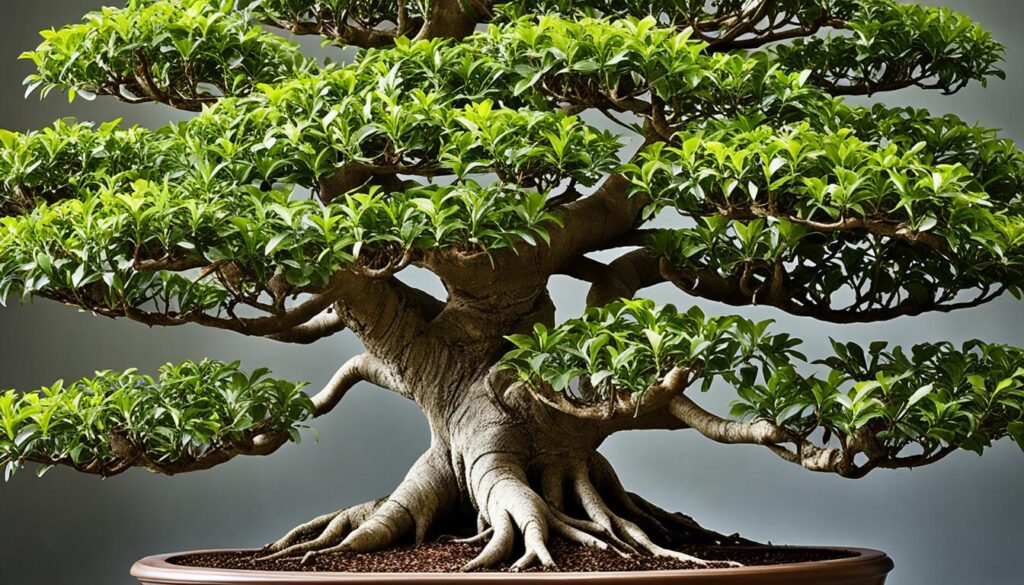
The Bonsai Ficus looks good and cleans the air. It’s also safe for your pets and doesn’t take up much space. So, adding one to your apartment is a great idea. It brings nature and peace inside your home.
How to Grow a Bonsai Ficus – Learn to Grow this Indoor Beauty
Growing Bonsai Ficus trees indoors is fun. Follow care guidelines to make your tree thrive.
In this section, we talk about how to grow a great Bonsai Ficus.
Choosing the Right Pot and Soil
Select a pot that fits your tree and looks nice. It needs to have drainage holes. For the soil, pick a blend that drains well but keeps moisture. Use a mix of Akadama, pumice, and lava rock for best growth.
Providing Adequate Light
Bonsai Ficus needs lots of light but not direct sunlight. Put it near a window with lots of natural light.
If there’s not enough natural light, use a grow light but keep it far enough to not harm the leaves.
Watering and Humidity
Water your Bonsai Ficus when the soil’s top feels dry. Make sure the water reaches the roots but don’t overdo it.
To keep it happy, use a humidity tray or a humidifier. This is especially important in dry places.
Nutrition and Fertilization
Your Bonsai Ficus needs good food to grow. Use a liquid bonsai fertilizer from spring to fall.
Follow what’s on the label. Change how much and how often based on how your tree grows.
Pruning and Maintenance
Pruning keeps your Bonsai Ficus looking good. It helps it grow the way you want. Remove bad branches to keep it healthy.
Check for pests, sickness, or stress. Deal with problems fast.
Propagation
Want more Bonsai Ficus trees? Try propagating. Use stem cuttings or air layering to make new plants.
Try different ways to see what’s best for you.
Monitoring for Pests and Diseases
Watch your tree for bugs and sickness. Common pests include aphids and spider mites. If you find pests, treat your tree right away.
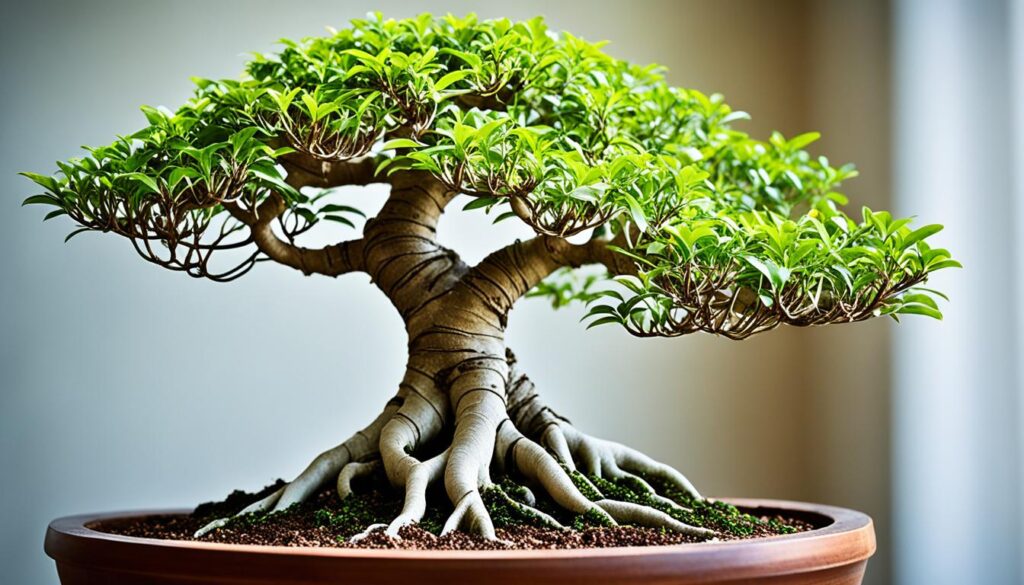
Appearance of Bonsai Ficus
Bonsai Ficus trees are amazing to see. They are mini versions of big trees but still so elegant. The shape and size can differ. It depends on how they are grown. Some look tall and straight. Others bend or look like they’re blown by wind.
The leaves of Bonsai Ficus are pretty too. They are small, shiny, and full of life. The leaves feel smooth and look bright. Their green colors make the tree stand out. It looks deeper and more beautiful.
Bonsai Ficus trees have other cool features too. You might see roots growing above ground. Or branches that spread out wide. These special touches make the trees look like art.
Want to see what Bonsai Ficus looks like? Check out the image below:
Light Requirements for Bonsai Ficus
Proper lighting is key for Bonsai Ficus trees to grow well. They need light for photosynthesis. This process lets them make energy from sunlight. Your Bonsai Ficus needs enough light indoors to be healthy.
Bonsai Ficus trees need different amounts of light based on their type. Yet, they all like bright, indirect light. It’s best to put your Bonsai near a window. Here, it can get natural light for a few hours daily. Use a sheer curtain to protect it from strong sunlight.
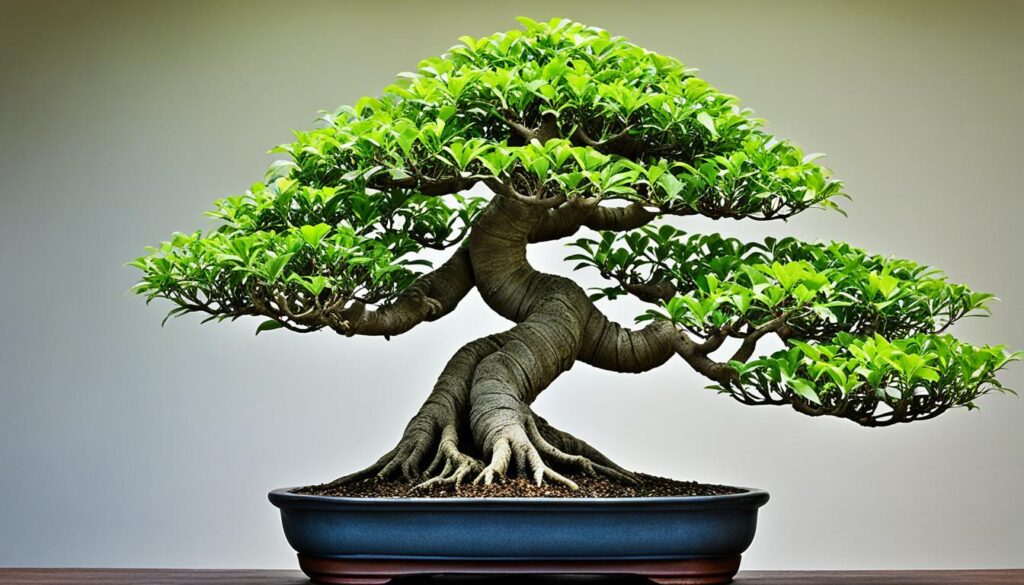
If you can’t get enough sunlight, use artificial lights for your Bonsai Ficus. You can use fluorescent or LED grow lights. Put the lights 6-12 inches above your tree. Keep them on for as long as the sun is usually out.
Remember, Bonsai Ficus trees can be okay with less light for a bit. But not for long. If they don’t get enough light, they might not grow well. Check your tree often. Make sure it gets the right light to stay healthy.
Watering Requirements of the Bonsai Ficus
It’s very important to water your Bonsai Ficus right. This helps it grow and stay healthy.
How often you water depends on the soil, air humidity, and the tree’s growth phase.
Water when the top inch of soil is dry. But, be careful not to water too much.
Too much water can make leaves yellow and soil soggy. It can also smell bad.
Not enough water leads to wilted leaves and dry soil. The tree won’t grow well.
Watch the moisture in the soil. Look for signs to know when to water it right.
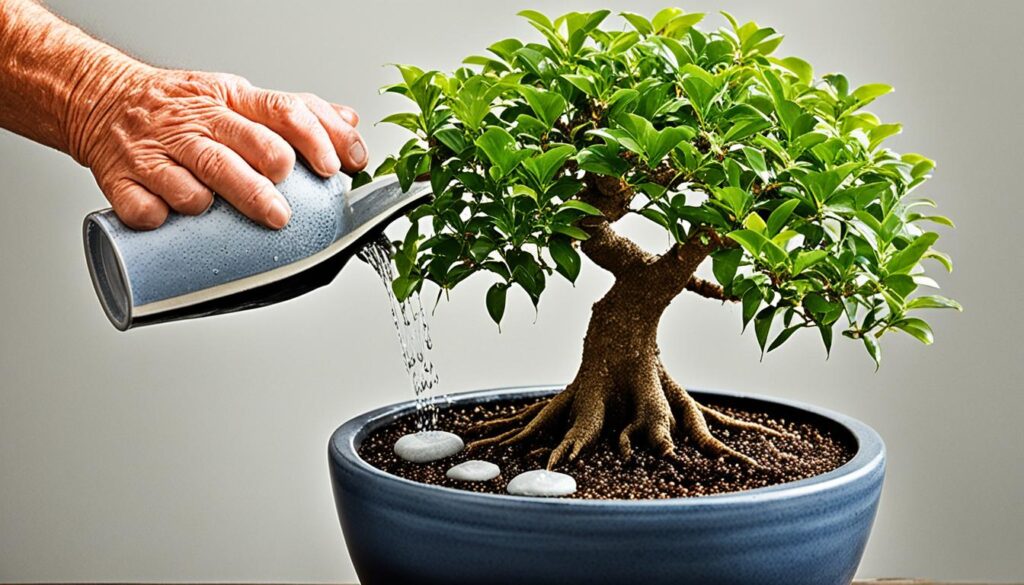
| Signs of Overwatering: | Signs of Underwatering: |
|---|---|
| – Yellowing leaves – Soggy soil – Musty smell | – Wilted or drooping leaves – Dry soil – Lack of growth vigor |
Each Bonsai Ficus is different. Watch and change how you water as needed. Proper care makes your tree beautiful and peaceful.
Fertilizing a Bonsai Ficus
Fertilizing a Bonsai Ficus tree is very important. It helps the tree grow healthy and strong. Fertilizers add nutrients to the soil that the tree needs. It makes the leaves bright and the roots strong. It’s important to use the right fertilizer for Bonsai Ficus trees.
Recommended Fertilizer for a Bonsai Ficus
Choose a balanced fertilizer for your Bonsai Ficus. It should have nitrogen (N), phosphorus (P), and potassium (K). These help the tree stay healthy and grow. A slow-release fertilizer is best. It feeds the tree slowly over time. Make sure the fertilizer doesn’t have too much salt. That can hurt the tree’s roots.
Brand X Bonsai Ficus Fertilizer is a good choice. It has an NPK ratio of 10-10-10. This is good for the tree’s growth and health. It also has iron and magnesium. These keep the leaves green. The slow-release formula helps the tree grow at a good pace.
When using fertilizer, follow the instructions on the package. You should usually fertilize every four to six weeks in spring and summer. In fall and winter, fertilize less to keep the tree from growing too much. Always look at your tree’s health to decide how much to fertilize.
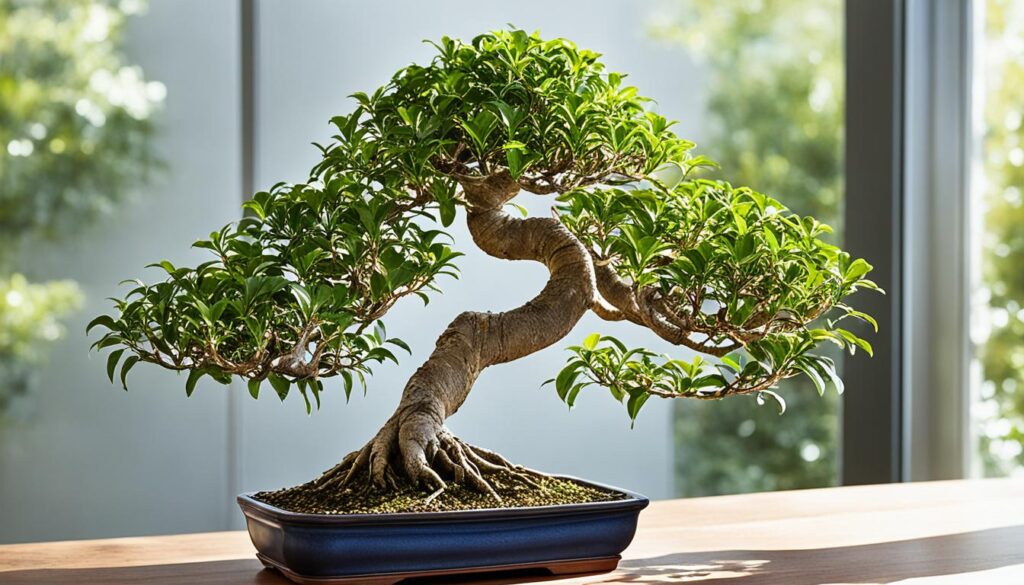
Potting a Bonsai Ficus
Proper potting is key for your Bonsai Ficus tree’s health and growth. I’ll guide you in choosing the right pot and mix. Knowing when to repot is also vital.
Choosing the Right Pot Size
Think about the tree’s age, root growth, and looks when picking a pot. It should match the tree’s size and let the roots grow.
A too big pot can harm. It makes the roots wet. A too small pot can stop roots growing. This isn’t good for the tree.
Using the Right Potting Mix for a Bonsai Ficus
The right mix is very important. It must drain well and let air through. This stops the roots from staying wet.
A good mix for a Bonsai Ficus has bonsai soil, perlite, and akadama or pumice. This mix helps with air flow and keeps moisture right.
Repotting When Necessary
Repot your Bonsai Ficus if it outgrows its pot or the soil gets hard. It’s best to do this every two to three years. Do it in spring or early summer.
Repotting lets you change the mix and trim the roots. This helps the tree grow well and have space.
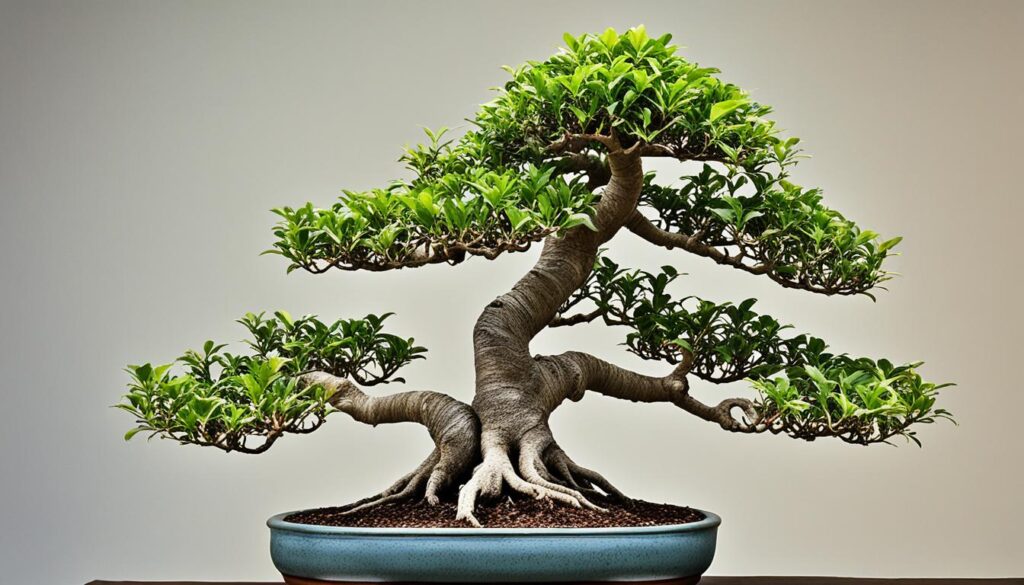
| Potting Tips | Benefits |
|---|---|
| Choose a pot with adequate drainage holes to prevent waterlogging. | Prevents root rot and allows excess water to escape. |
| When repotting, gently loosen the root ball to encourage new root growth. | Promotes a healthier and more robust root system. |
| Use a bonsai-specific potting mix to provide the right balance of drainage and moisture retention. | Ensures optimal root health and growth. |
| Monitor the tree’s growth and repot only when necessary. | Prevents unnecessary stress to the tree and maintains its overall health. |
Propagating a Bonsai Ficus
Propagating Bonsai Ficus trees is fun. It lets you grow your collection. You can use stem cuttings or seeds. Each way has good and bad points. Let’s take a closer look.
Stem Cuttings Or Seeds?
Stem cuttings are a favorite way to grow Bonsai Ficus. You cut a piece from a healthy plant. Then, you make it grow roots. This way is fast. It keeps the parent plant’s traits. It’s perfect if you want a copy of your Bonsai Ficus.
But, growing Bonsai Ficus from seeds is also rewarding. You see the tree grow from start to finish. Yet, it needs more patience. Trees from seeds take longer to grow. Seeds make each Bonsai Ficus unique.
Division Of A Bonsai Ficus
Division is another way to grow Bonsai Ficus. You split one Bonsai Ficus into many. Each one must have roots and leaves to live. Use division when your tree is too big. Or when you want more trees from one.
Be careful when you divide. Trim roots and leaves right. This helps your trees stay healthy. This method lets you try different Bonsai styles.
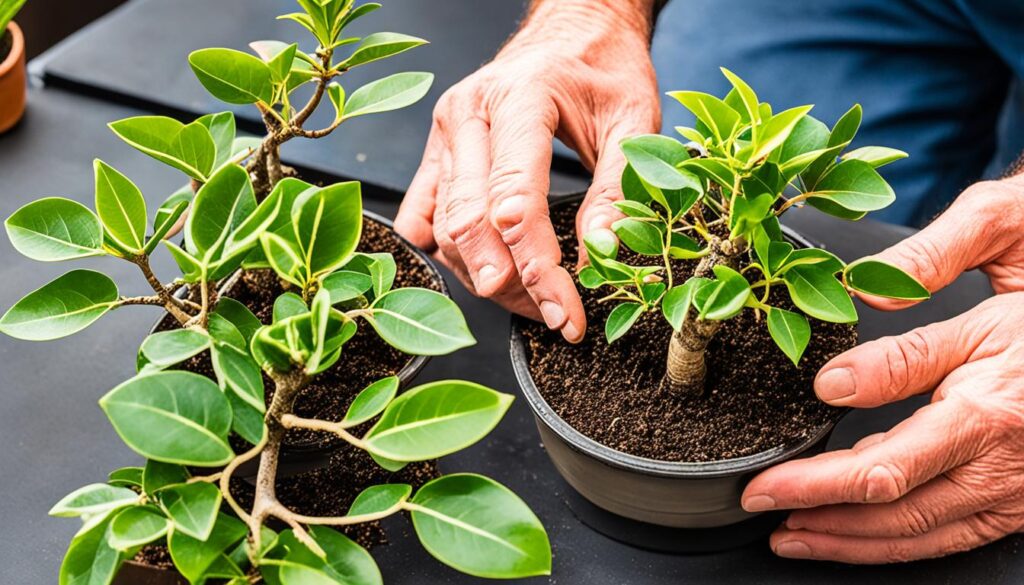
Propagating Bonsai Ficus trees has many choices. Use stem cuttings, seeds, or division. Each way brings something special. Trying different ways to grow can teach you a lot. It’s fun to watch new Bonsai Ficus trees grow!
Growth and Development of the Bonsai Ficus
Bonsai Ficus trees grow from tiny seeds or cuttings into beautiful trees. It’s important to know about their growth to take good care of them.
A Bonsai Ficus begins as a small seed or cutting. Then, it starts to grow a trunk, branches, and leaves. It slowly looks more like a bonsai tree.
Many things affect how a Bonsai Ficus grows. The right light, warmth, and moisture are very important. Good light helps the tree make food and grow.
Pruning helps shape the tree. It makes the tree look how we want. The right food helps the tree stay healthy and grow well.
As they grow, Bonsai Ficus trees reach new milestones. They get their first leaves and a tiny canopy. Caring for them needs patience. It takes years for them to fully grow.
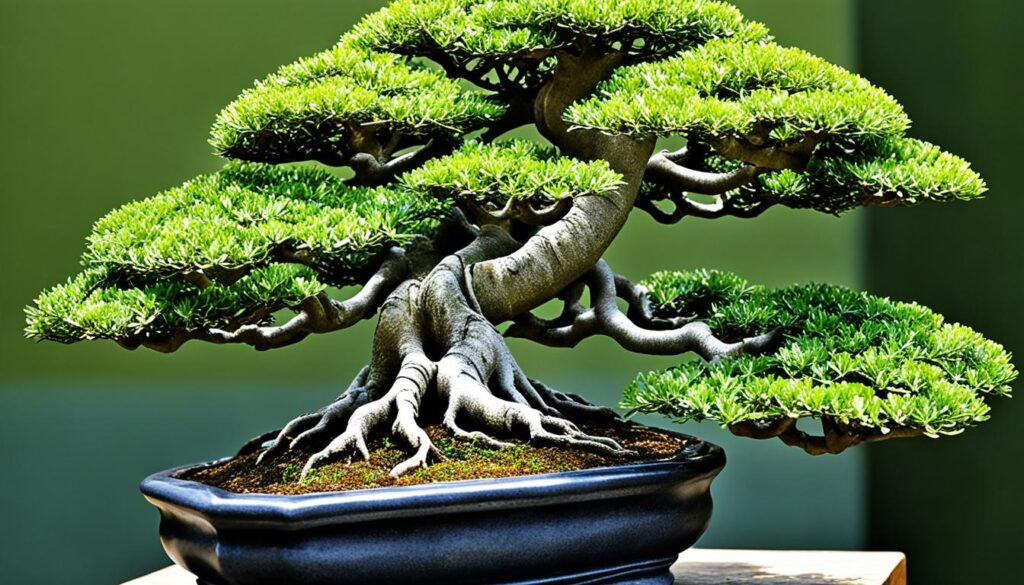
Dealing with Pests and Diseases in the Bonsai Ficus
Pests and diseases can hurt your Bonsai Ficus trees. Spotting them early is very important. It helps stop and treat them fast. This keeps your bonsai trees healthy and happy.
Bonsai Ficus trees might get bugs like aphids, scale insects, and spider mites. These bugs can harm the leaves and slow down tree growth. They can also make the tree weak. It’s important to check the leaves and stems often. Look for sticky stuff, yellow leaves, or tiny webs.
If bugs do show up, you can fight them in different ways. Using ladybugs or predatory mites works well. They eat the bad bugs. Keeping sick plants away from healthy ones stops bugs from spreading. You might need to use special chemicals for your Bonsai Ficus if it gets really bad.
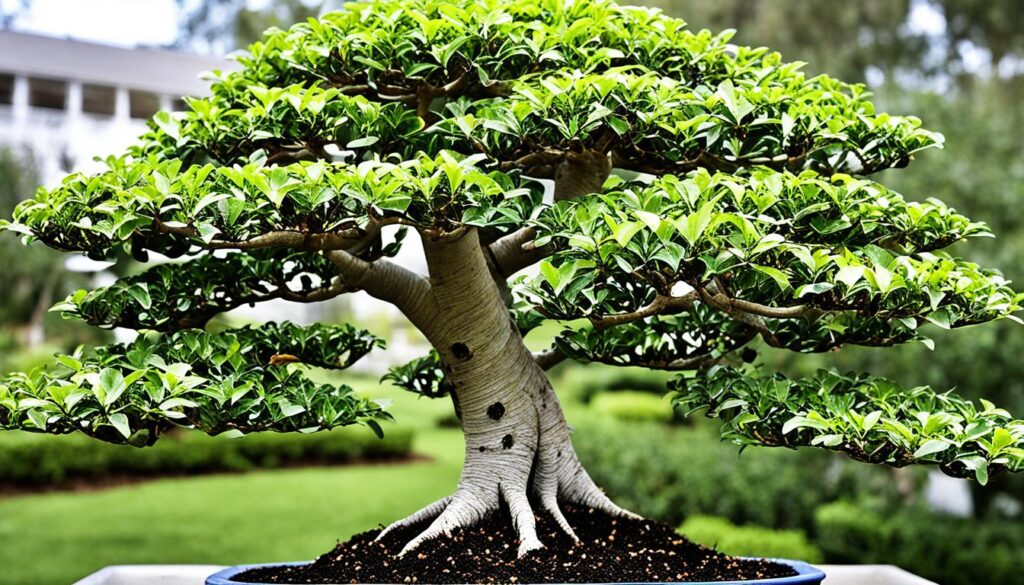
Diseases can also hurt Bonsai Ficus trees. Fungus and bacteria are common problems. Spots on leaves, color changes, and droopy leaves are signs. To stop diseases, water your trees right and keep their home clean.
If your Bonsai Ficus gets sick, find it fast. Remove sick leaves or branches right away. Using the right medicines can help stop the disease. This keeps your tree safe.
To keep your bonsai trees healthy, you need to watch them closely. Act fast if you see bugs or disease. Taking early steps and being careful can protect your bonsai trees.
Common Bonsai Ficus Pests
To keep your Bonsai Ficus trees healthy, know the pests. Learn about their looks, life cycle, and harm to Bonsai Ficus. Knowing this helps you deal with pests.
Mealybugs are a big problem for Bonsai Ficus trees. They look white and cottony. They hang out in groups on leaves and stems. Mealybugs eat plant sap. This causes slow growth and yellow leaves.
Quote: “Mealybugs can be controlled by using insecticidal soap or horticultural oil. Regularly inspect your Bonsai Ficus and remove any visible mealybugs with a cotton swab dipped in rubbing alcohol.”
Aphids also attack Bonsai Ficus trees. They are small and come in colors like green, black, brown. Aphids are found under leaves. They make leaves curl and turn yellow. To fight aphids, use soap or water spray.
Quote: “To control aphids, you can use insecticidal soap or spray them off the plant with a strong stream of water.”
Spider mites are tough on Bonsai Ficus. They are tiny and make webs on plants. They suck leaf fluids, causing yellowing and leaf drop. Spider mites like dry places. Keep your Bonsai Ficus misted and humid to fight them.
Quote: “Regularly misting your Bonsai Ficus and maintaining adequate humidity levels can help prevent spider mite infestations.”
Bonsai Ficus trees can get scaled, thrips, and fungus gnats too. Always check your Bonsai Ficus for pests. Take steps to control and stop them. This keeps your Bonsai Ficus beautiful and healthy.
Natural Predators
Nature provides helpers for pest control in Bonsai Ficus trees. These helpers include beneficial insects and animals. They eat common pests. This helps keep your garden healthy.
Attracting and Supporting Natural Predators
Create a welcoming space for these helpers. Plant different types of plants. Different predators like different plants. Avoid pesticides because they can hurt the beneficial insects. Use organic methods to deal with pests.
Some helpful predators for your Bonsai Ficus trees are:
- Ladybugs: They eat aphids, mealybugs, and others.
- Praying mantises: They eat many pests, like caterpillars and beetles.
- Lacewings: Their young eat lots of aphids, thrips, and mites.
- Green lacewings: Their larvae are great at eating aphids.
Isolate Infected Plants
If a Bonsai Ficus tree gets sick, separate it quickly. This stops the pests or disease from spreading. It helps keep your trees healthy. It also reduces the need for chemicals.
Chemical Treatment
Sometimes, you might need chemicals to fight pests or disease. This should be your last option. Talk to an expert or a garden center for advice. Follow instructions carefully. Use chemicals sparingly to protect your trees and nature.
The goal is to balance your Bonsai Ficus ecosystem. Let nature help you and minimize using chemicals.
Disease Prevention For Bonsai Ficuses
Keeping Bonsai Ficus trees healthy is very important. They can get sick from fungi and bacteria. To keep your Bonsai Ficus healthy, you need to take steps to stop diseases. Also, make sure they grow in a healthy place.
How you water your tree is key in stopping diseases. Too much water causes root rot and fungus. Not enough water makes the tree weak and sick. You must find the right amount of water for your Bonsai Ficus.
Keeping things clean helps stop diseases too. Check your tree for yellow leaves or spots. If you see these signs, cut off the bad leaves or branches. Use clean tools to stop the disease from spreading.
Having a good place for your tree to grow helps prevent disease. Make sure your Bonsai Ficus has enough air and is not too close to other plants. Don’t let it get too humid to avoid fungus.
Remember, it’s better to stop disease before it starts with Bonsai Ficuses. Water right, stay clean, and give your plant a good home. This will help keep your Bonsai Ficus safe from diseases.
| Common Diseases | Preventive Measures |
|---|---|
| Fungal infections |
|
| Bacterial diseases |
|
Tips for Maintaining Bonsai Ficuses
Bonsai Ficus trees need the right care to stay healthy and live long. Here are simple tips to keep your Bonsai Ficus looking great:
Wiping Leaves
It’s key to wipe your Bonsai Ficus tree’s leaves to get rid of dust and bugs. Use a soft, damp cloth or sponge for cleaning.
This makes the tree breathe well and soak up more sunlight. It also stops bugs from coming and keeps the leaves looking bright and healthy.
Outdoor Exposure
Your Bonsai Ficus tree being outside can be good for it. It gets to be in natural sunlight, breathe fresh air, and feel different temperatures.
This can make the tree stronger and grow more. But bring your tree outside slowly and watch it carefully. This stops shock from sudden weather changes.
Adjusting Watering Schedule
It’s key to watch and change how much you water your Bonsai Ficus. The tree’s water needs can change with the weather, air wetness, and how much it has grown.
In hot, dry times, it might need more water. In cool times, it needs less. Only water when the soil’s top inch is a bit dry.
By doing these things, your Bonsai Ficus tree will be healthy and happy for many years.
Tips for Successful Overwintering of Bonsai Ficus
Keeping Bonsai Ficus trees safe in winter is key. When it gets cold and frosty, you must protect your bonsai.
Here are some tips to help:
- Protect from cold temperatures and frost: Bonsai Ficus trees can’t handle freezing. Think about moving it indoors to a cool spot. Use burlap to wrap the pot and trunk if it’s outside.
- Provide proper lighting: Winter means less sunlight. Put your Bonsai Ficus by a window that gets lots of light. Or, use extra lights to keep it healthy.
- Maintain appropriate humidity: Heating your home can make the air dry. To help your bonsai, use a humidifier or a tray of water and stones. Spraying water on it also works well.
- Adjust watering and fertilization: Bonsai trees need less water and food in winter. Water it just enough to keep it from getting too dry. Cut back on fertilizer too.
- Monitor for pests and diseases: Keep an eye out for bugs or sickness, even in winter. Look for yellow leaves or odd growth. Act fast if you see any problems.
Follow these tips for a happy Bonsai Ficus in winter. Change how you care for it as the weather changes. This will keep your bonsai doing well all winter long.
Growing Bonsai Ficus from Seed
Want to start growing Bonsai Ficus trees from scratch? It’s a rewarding journey. It takes time and patience but lets you see the tree’s life from seed to tree.
First, get high-quality Bonsai Ficus seeds from nurseries or online. Then follow these steps to grow your Bonsai Ficus trees:
- Prepare the soil: Use well-draining soil that’s good for Bonsai Ficus. Mix organic and inorganic stuff, like peat moss, perlite, and sand. This mix keeps the soil airy and moist right.
- Plant the seeds: Use a seed tray or pot with your soil mix. Make small holes for the seeds. Put the seeds in these holes as the seed package says.
- Provide optimal conditions: Keep the seed tray or pot warm and bright but out of direct sun. A steady warmth of 70-75°F (21-24°C) helps seeds sprout well.
- Water carefully: The soil should be moist but not too wet. Too much water causes rot, and too little dries the seeds out. Mist the soil to keep moisture right.
- Be patient: Seeds might take weeks or months to germinate. Watch the soil’s moisture and wait for the seeds to grow.
- Care for the seedlings: When seedlings appear, they need bright, indirect light. Slowly, you can give them more sun. Keep the soil nicely moist but not too wet.
By growing Bonsai Ficus from seed, you can shape your plants from the start. It takes dedication but connects you to nature and bonsai art.
If you’re patient and take good care, your seeds will become beautiful Bonsai Ficus trees. They make your indoor space peaceful and pretty.
Varieties of Bonsai Ficus
When it comes to Bonsai Ficus trees, you have many types to pick. Each one has unique looks and grows differently. Some liked ones are Ficus Retusa, Ficus Ginseng, and Ficus Benjamina. Let’s explore these types and their special features.
Ficus Retusa or Banyan Fig is a tropical plant with shiny leaves. It has roots that look cool when trained. This type is easy to adapt and grows well inside or outside.
Ficus Ginseng has a thick trunk and lots of dark leaves. People who love bonsai like it for its fun look. It’s not hard to care for and does well in many lights.
Ficus Benjamina is also called Weeping Fig. It has thin branches and small, shiny leaves that look pretty. This one likes bright light but is tricky to care for. Ficus Benjamina can be sensitive to changes in its environment, so it’s important to maintain a consistent humidity and temperature. To ensure its health, regular pruning can help maintain its shape and encourage new growth. For those also interested in growing other plants like spiral cacti, it’s essential to look into spiral cactus care tips to provide the right conditions for each type.
Choosing a Bonsai Ficus means thinking about what you like and where it’ll live. Each type needs different light, warmth, and care. Picking the right one lets you make a beautiful bonsai set that shows your style and makes your space better.
FAQ
Q: Why are Bonsai Ficus trees popular choices for apartments?
A: Bonsai Ficus trees clean the air.
They fit well in small spaces because they are small.
Q: Is Bonsai Ficus air-purifying?
A: Yes, Bonsai Ficus trees clean the air.
They take out bad stuff like formaldehyde.
Q: Is Bonsai Ficus pet-friendly?
A: Bonsai Ficus trees are mostly safe for pets.
But, they can be harmful if pets eat too much.
Q: How big does the Bonsai Ficus get?
A: The size of a Bonsai Ficus tree varies.
They usually grow to 1 to 3 feet tall indoors.
Q: How do I choose the right pot and soil for my Bonsai Ficus?
A: Choose a pot that fits the tree’s size and looks nice.
Use soil that drains well but keeps some water.
Q: How much light does a Bonsai Ficus need?
A: Bonsai Ficus trees need bright, indirect light.
They should be near a window or have a grow light.
Q: How often should I water my Bonsai Ficus?
A: Water your Bonsai Ficus when the top soil is dry.
Don’t water too much to avoid root rot.
Q: What fertilizer should I use for my Bonsai Ficus?
A: Use a balanced fertilizer made for Bonsai Ficus.
Follow the directions on when and how much to use.
Q: How do I propagate my Bonsai Ficus?
A: You can grow Bonsai Ficus from cuttings or seeds.
Stem cuttings are easier to start growing.
Q: How does a Bonsai Ficus grow and develop?
A: Bonsai Ficus trees grow from a seed or cutting into a mature tree.
How they grow depends on their environment and care.
Q: How do I deal with pests and diseases in my Bonsai Ficus?
A: Watch your Bonsai Ficus for bugs and sickness.
Use treatments as needed and keep the tree healthy.
Q: What are the common pests that can affect my Bonsai Ficus?
A: Watch out for aphids, spider mites, scales, and mealybugs.
They can harm your tree if not treated.
Q: Are there natural predators that can help control pests in my Bonsai Ficus?
A: Ladybugs, lacewings, and birds can eat pests.
If these don’t work, you might need chemicals.
Q: How can I prevent diseases in my Bonsai Ficus?
A: To avoid sickness, don’t overwater and make sure the soil drains.
Keep leaves dry and clean up dead ones.
Q: What are some tips for maintaining my Bonsai Ficus?
A: Keep leaves clean and let the tree get fresh air.
Change how much you water with the seasons.
Q: How do I overwinter my Bonsai Ficus successfully?
A: Keep your Bonsai Ficus warm and inside during cold months.
Give it enough light and water just right.
Q: Can I grow a Bonsai Ficus from seed?
A: Yes, you can grow a Bonsai Ficus from seed.
It takes patience because it’s a slow process.
Q: What are the different varieties of Bonsai Ficus?
A: There are many Bonsai Ficus types like Ficus Retusa and Ficus Ginseng.
Choose one that you like and will grow well in your home.

